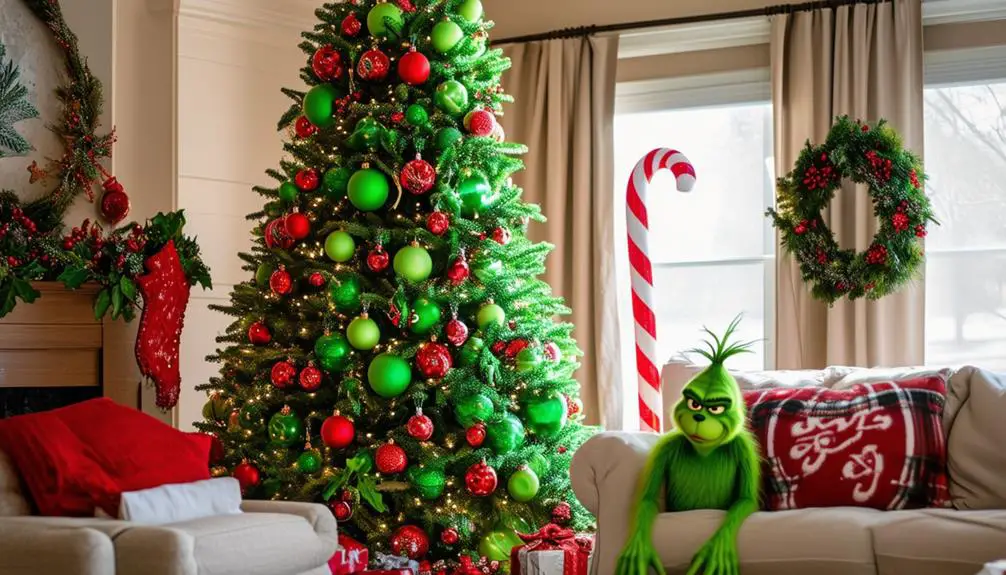You're about to bring home your new succulent, and you can't wait to show it off. But before you do, take a step back and consider what it takes to keep your new plant thriving. It's not as simple as just watering it and placing it on a sunny windowsill. In fact, succulents require a delicate balance of light, water, and nutrients to survive. Get it wrong, and you'll be left with a wilted, dying plant. But don't worry, with the right knowledge, you can create a stunning display of vibrant, healthy succulents that will impress anyone. Now, let's get started on the journey to succulent success.
Choosing the Right Succulent
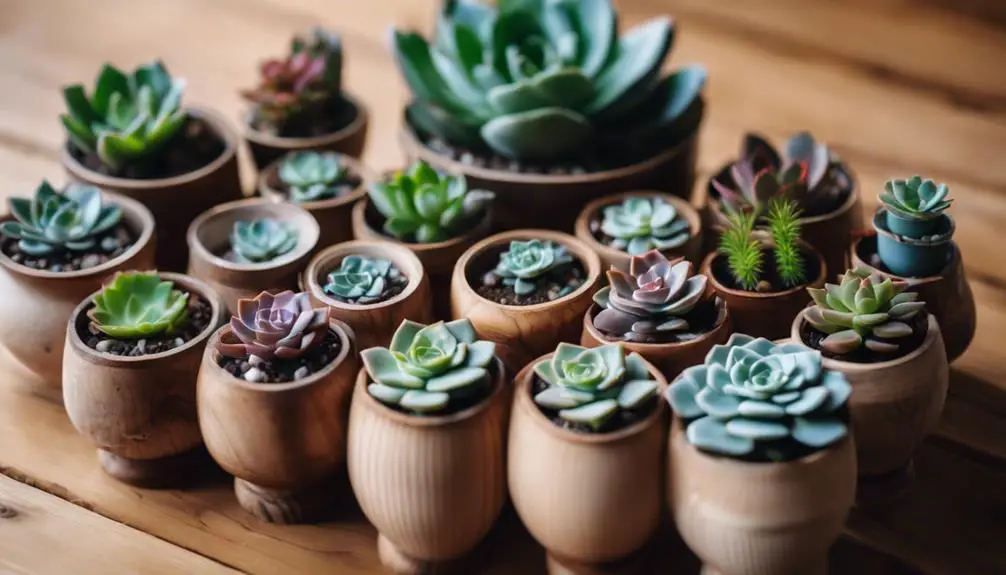
When selecting a succulent, consider the specific growing conditions you can provide, as different species thrive in varying levels of light, temperature, and humidity. You'll want to choose a succulent that fits your lifestyle and environment.
With over 60 succulent types, you're spoiled for choice. From the popular Aloe Vera to the rare and exotic, each species has its unique characteristics, such as shape, size, and succulent colors.
Some succulents, like Echeveria, boast vibrant colors like pink, blue, and yellow, while others, like Crassula, have subtle, muted tones.
Consider the color palette you want to incorporate into your space. Do you prefer bold and bright, or soft and subtle?
Additionally, think about the level of maintenance you're willing to commit to. Some succulents, like Sedum, are low-maintenance and can thrive in neglect, while others, like Kalanchoe, require more attention.
Lighting Needs for Succulents
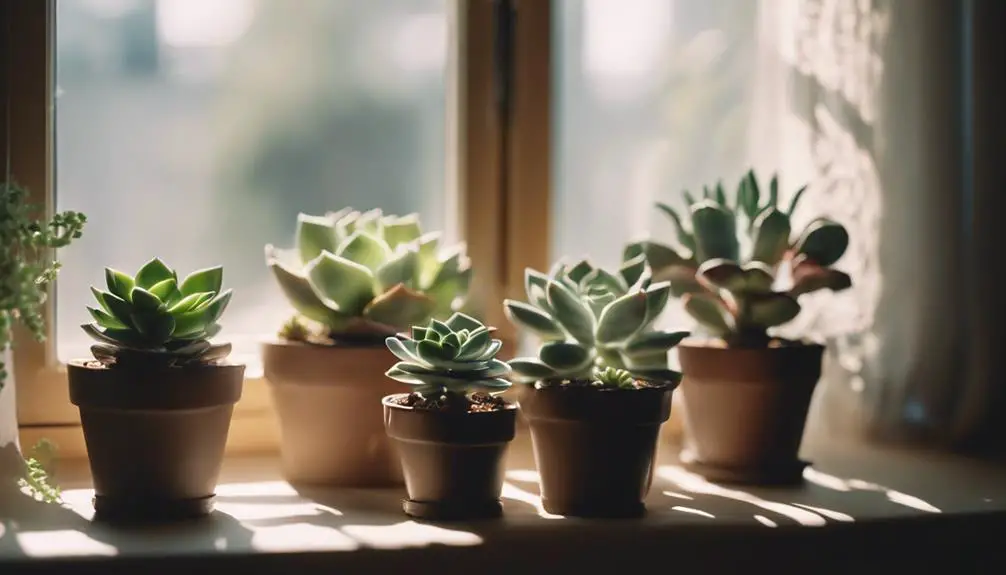
When it comes to lighting needs for your succulents, you'll need to ponder the specific requirements of your plants.
Some succulents thrive in direct sunlight, while others prefer bright indirect light or can even tolerate low light conditions.
You'll need to understand the lighting needs of your specific succulent species to guarantee they receive the right amount of light to stay healthy and thrive.
Direct Sunlight Requirements
You'll need to provide your succulents with sufficient direct sunlight, as most species require at least 4-6 hours of intense, unfiltered sunlight daily to thrive.
When it comes to direct sunlight, South exposure is ideal, as it receives the most intense sunlight throughout the day. If South exposure isn't possible, an East window is a good alternative. However, keep in mind that East windows receive gentler morning sunlight, which may not be intense enough for some succulent species.
To guarantee your succulents receive the right amount of direct sunlight, consider the following factors: time of day, season, and window orientation.
During the summer months, you may need to provide shade for your succulents to prevent scorching. In the winter, you can gradually increase their exposure to direct sunlight as the days get longer.
Bright Indirect Light Options
If direct sunlight isn't feasible, bright indirect light can be a suitable alternative for your succulents, providing they receive sufficient illumination to undergo photosynthesis. This type of lighting is ideal for succulents that can't tolerate intense direct sunlight, but still require a decent amount of light to thrive.
East windows and North windows are excellent options for providing bright indirect light to your succulents. These windows receive gentle, filtered sunlight that won't scorch your plants, but will still promote healthy growth and development. Position your succulents 2-3 feet away from these windows to guarantee they receive the right amount of indirect light.
Keep in mind that bright indirect light can vary in intensity depending on the time of day and season. During the winter months, you may need to move your succulents closer to the window to compensate for the weaker sunlight. Conversely, during the summer months, you may need to provide some shade to prevent overheating. By understanding the nuances of bright indirect light, you can create a perfect environment for your succulents to flourish.
Low Light Tolerances
How much light can your succulents survive with, and what're the consequences of inadequate illumination?
While succulents are known for their high light tolerance, some species can still thrive in low-light conditions. However, prolonged periods of inadequate light can lead to weakened plants, reduced growth, and increased susceptibility to disease.
To combat this, you can utilize Low Light Adaptations, such as selecting species that are naturally adapted to shade, like Haworthia or Peperomia.
Alternatively, you can employ Artificial Lighting Solutions, like LED grow lights, to supplement natural light.
When choosing an artificial light source, consider the color temperature and intensity to confirm it meets your succulent's specific needs.
Watering Your Succulents Properly
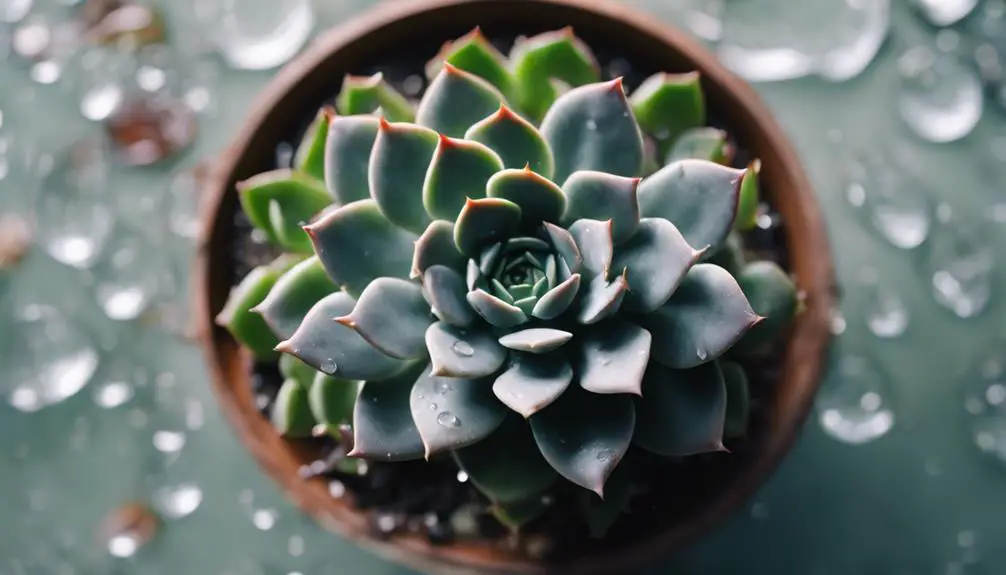
Watering your succulents properly requires a delicate balance between hydration and drying out, as these plants thrive in conditions where the soil is moist but not waterlogged.
To achieve this balance, you need to get the watering frequency just right. Overwatering is one of the most common mistakes succulent owners make, and it can be fatal.
You should water your succulents only when the soil has dried out completely, usually every 7-10 days in the summer and less often in the winter.
Check the soil moisture by sticking your finger into the soil up to the first knuckle. If it feels dry, it's time to water.
When you do water, make sure to water thoroughly, allowing excess water to drain out of the pot.
Avoid getting water on the leaves to prevent rotting.
Underwatering, on the other hand, can cause succulents to shrivel and lose their vibrant colors.
Potting Soil for Succulents

You'll want to pair your well-watered succulents with a potting soil that's specifically designed to accommodate their unique needs.
When it comes to soil texture, succulents thrive in well-draining mixes that prevent waterlogged soil. A mix with a coarse texture, containing ingredients like perlite, vermiculite, or sand, will help excess water drain quickly, reducing the risk of root rot.
Avoid using regular potting soil, as it can retain too much water and cause your succulents to rot.
The importance of drainage can't be overstated. Succulents have adapted to store water in their leaves, stems, or roots, so they don't need a lot of moisture in the soil.
In fact, overwatering is one of the most common causes of death in succulents. By using a well-draining potting soil, you'll guarantee that your succulents receive the right amount of moisture without drowning them.
Look for a mix that's specifically labeled as 'cactus mix' or 'succulent mix' to certify it's designed with your plants' unique needs in mind.
Fertilizing Your Succulents

Fertilizing your succulents is a crucial step in providing them with the necessary nutrients for ideal growth, as they require more than just water and sunlight to thrive.
When it comes to choosing a fertilizer, you'll want to select one that's specifically formulated for cacti and succulents. There are two main types of fertilizers: water-soluble and granular. Water-soluble fertilizers are easy to use and provide immediate results, while granular fertilizers release nutrients slowly over time.
Regardless of the type you choose, make sure it provides a balanced nutrient ratio. A 20-20-20 formula, which contains equal parts nitrogen, phosphorus, and potassium, is a good starting point.
However, some succulents may require a slightly different balance, so be sure to research the specific needs of your plants. Overfertilization can be detrimental, so start with a weak solution and gradually increase as needed.
Fertilize your succulents during the growing season (spring and summer) and avoid fertilizing during the dormant season (fall and winter).
Repotting Succulents Successfully

As your succulents outgrow their containers, they'll need room to spread out and develop a robust root system, making repotting a necessary step in their lifecycle.
When your succulent has outgrown its container, typically indicated by a significant increase in succulent size, it's time to repot.
Choose a pot that's only one to two sizes larger than the current one to prevent the soil from becoming too wet. Gather your potting tools, including a new pot, well-draining potting mix, and a gentle trowel or spoon.
Carefully remove the succulent from its pot, taking note of any roots that need to be gently teased apart. Inspect the roots for any signs of rot or damage and trim them off if necessary.
Place the succulent in its new pot, adding fresh potting mix around the roots, and gently firm it in place. Water sparingly after repotting to prevent root rot.
Pruning and Grooming Techniques
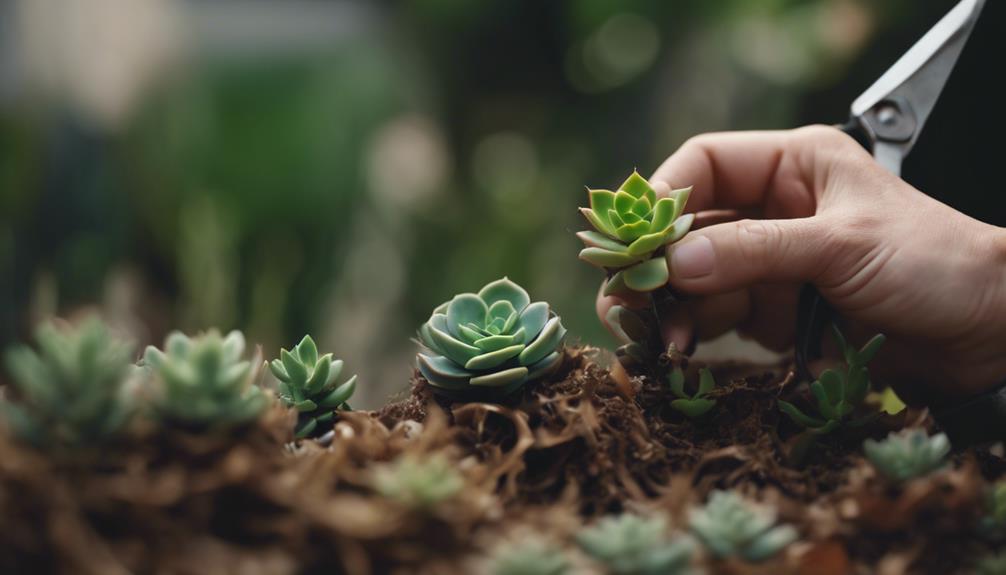
When pruning and grooming your succulents, you'll want to focus on a few key areas to keep them looking their best.
You'll need to remove dead leaves, which can attract pests and create an environment for disease, and shape the plant's structure to maintain its natural beauty.
Remove Dead Leaves
Pruning dead leaves from your succulent helps maintain its appearance and promotes healthy growth by preventing the spread of disease and encouraging new foliage.
Dead leaves can harbor fungal diseases and pests, which can spread to other parts of the plant if left untouched.
By removing dead leaves, you're preventing leaf decay and creating a healthier environment for your succulent to thrive.
To remove dead leaves, gently twist or cut them off at the base, making sure not to damage any surrounding tissue.
Dispose of the removed leaves to prevent them from spreading disease to other plants.
Regular dead leaf removal also encourages your succulent to focus its energy on producing new growth, rather than wasting resources on dying leaves.
Additionally, removing dead leaves improves air circulation around the plant, reducing the risk of fungal diseases.
Shape Plant Structure
You can now focus on shaping your succulent's structure by applying targeted pruning and grooming techniques to maintain its desired shape and encourage balanced growth.
Succulent pruning is an art that requires precision and patience. Start by identifying areas where your plant is becoming leggy or uneven. Using clean, sharp scissors or clippers, carefully trim back over-extending stems to the desired length. This will encourage new growth and promote a bushier appearance.
Next, consider branch training to create a more visually appealing structure. Gently twine or stake stems to encourage them to grow in a specific direction. This technique is particularly effective for trailing succulents like Sedum or Burro's Tail.
As you prune, pay attention to the plant's natural growth patterns, and work with them to create a harmonious shape. Remember, the goal is to enhance your succulent's natural beauty, not to force it into an unnatural shape.
Trim Overgrown Segments
By regularly trimming overgrown segments, you'll prevent your succulent from becoming leggy and promote a fuller, more compact shape.
This vital pruning technique encourages succulent rejuvenation, allowing your plant to redirect its energy towards healthy growth. Using clean, sharp scissors or pruning shears, carefully trim back overgrown stems to about an inch from the soil.
Make sure to remove any weak or damaged segments, as these can attract pests and diseases.
When reshaping segments, focus on maintaining a balanced, symmetrical shape.
Cut back stems at a 45-degree angle, just above a leaf node, to encourage new growth. You can also trim off any spindly or awkwardly shaped segments to create a more visually appealing plant.
Regular trimming won't only improve your succulent's appearance but also promote healthy growth and prevent overcrowding.
Pest Control for Succulents
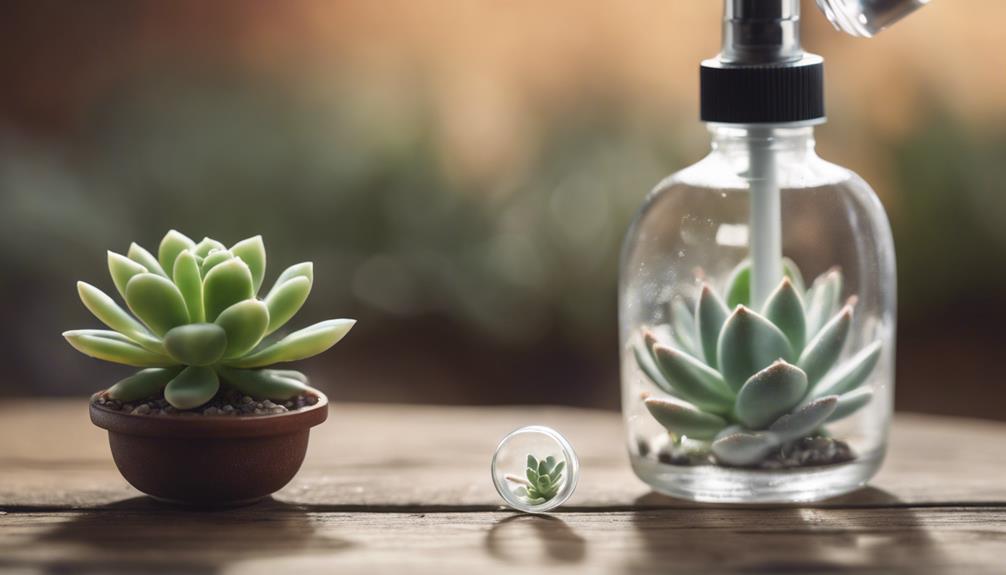
Pest Control for Succulents
At least 75% of succulent deaths are caused by pests, which can quickly spread from plant to plant if left unchecked.
To prevent this, you'll need to stay vigilant and take proactive measures. Start by performing regular pest inspections on your succulents.
Inspect the leaves, stems, and soil for any signs of pests, such as white powdery residue, tiny eggs, or actual pests. Check for pests in hard-to-reach areas, like the base of the leaves or in the soil crevices.
If you do find pests, don't panic.
You can use organic pesticides to control the infestation. Neem oil, insecticidal soap, and horticultural oil are all effective options.
These pesticides are gentle on your succulents but tough on pests. Always follow the instructions on the label and take necessary precautions to avoid exposing yourself or other plants to the pesticides.
Common Succulent Pests to Watch
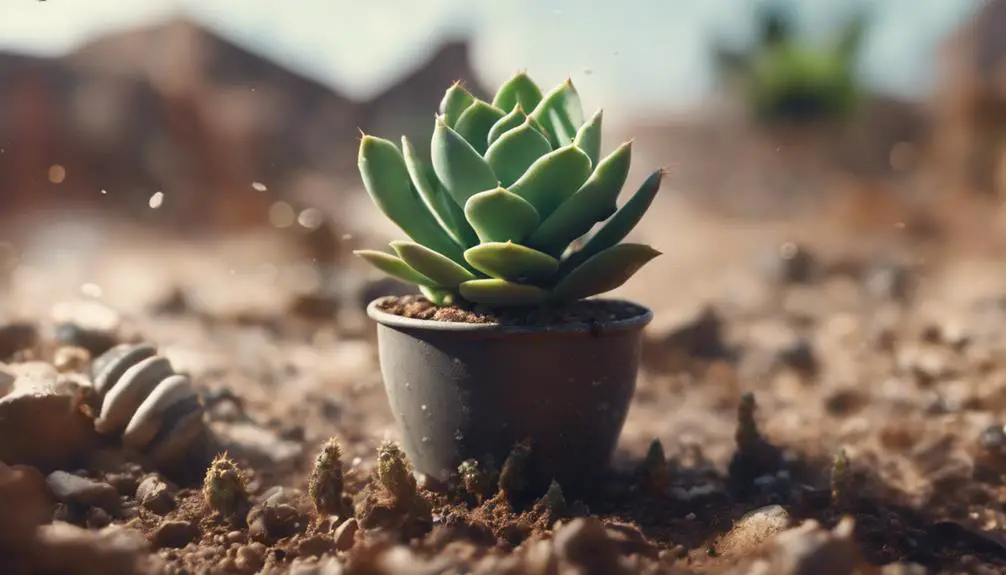
When inspecting your succulents, you'll want to be on the lookout for common pests that can quickly wreak havoc on your plants.
You'll need to recognize the signs of mealybug infestations, such as white, cottony patches on stems and leaves, and know how to detect spider mites, which can cause yellowing or bronzing of foliage.
Mealybug Infestation Signs
You'll frequently notice mealybug infestations on your succulents by looking for small, cottony patches or white, powdery residue on the leaves, stems, or soil. These tiny, soft-bodied insects secrete a waxy, cotton-like substance as they feed on your plant's sap, leaving behind these telltale signs.
Check for mealybug eggs, which are usually laid in a white, cottony mass on the underside of leaves or along infested stems.
As the infestation progresses, you might notice your succulent's growth slowing, leaves becoming distorted, or stems becoming weak and brittle. Mealybugs can also attract ants, which can further compromise your plant's health.
Be sure to inspect your succulents regularly, especially when introducing new plants to your collection. Early detection is key to preventing the spread of mealybugs and minimizing damage to your plants.
Spider Mite Detection
Inspecting your succulents closely for subtle changes in color, texture, or webbing can help detect spider mite infestations, which often manifest as faint yellow, bronze, or white speckles on the leaves' undersides.
These tiny, eight-legged pests are barely visible to the naked eye, but their presence can cause significant damage to your plants. Spider mites thrive in dry, warm conditions, making succulents an ideal target.
To confirm the presence of spider mites, gently shake a leaf over a white sheet of paper or a white surface. If you notice tiny, moving dots, it's likely a spider mite infestation.
You can also look for fine, wispy spider webs on the leaves or stems, which are a telltale sign of an infestation. Check for mite eggs, too, which appear as tiny, translucent spheres on the undersides of leaves.
If you've identified a spider mite problem, isolate the affected plants, and treat them with insecticidal soap or neem oil to prevent the infestation from spreading.
Dealing With Overwatering Issues

Overwatering is the most common cause of death in succulents, and vitally, you must identify the signs of too much moisture to prevent further damage.
Check for yellowing or soft leaves, as these are indicative of water damage.
If you notice your succulent's leaves are mushy or falling off, it's likely that root rot has set in.
In this case, you'll need to act fast to save your plant.
First, stop watering immediately to prevent further damage.
Then, inspect the roots to see if they're rotting.
If so, gently remove the affected roots and repot the succulent in well-draining soil.
Make sure the pot has good drainage holes to prevent water from accumulating.
You can also try to propagate a new succulent from a healthy leaf or stem cutting.
Succulent Temperature Requirements

Now that you've addressed potential water damage, it's time to focus on providing your succulent with the ideal temperature range to thrive.
Succulents generally prefer temperatures between 65-75°F (18-24°C) during the day and no lower than 55°F (13°C) at night. However, some species can tolerate higher or lower temperatures, so research is crucial to determine the specific needs of your succulent.
Temperature fluctuations can cause thermal stress, which can lead to weakened plants and increased susceptibility to disease.
To minimize temperature fluctuations, avoid placing your succulent near heating or cooling vents, fireplaces, or drafty windows. You should also keep your succulent away from extreme temperatures, such as those near ovens or refrigerators.
When moving your succulent outdoors, make certain it's acclimated to outdoor temperatures gradually to prevent shock.
If you live in an area with freezing temperatures, bring your succulent indoors during the winter months or provide protection from frost.
Humidity Levels for Succulents

You'll want to maintain a humidity level between 40-60% for most succulent species, as they thrive in relatively dry air. Succulents have adapted to arid environments, and high humidity can lead to root rot and other issues.
However, some species, like aloe vera, can benefit from slightly higher humidity levels.
To achieve the ideal humidity range, you can create humid microclimates around your succulents. Grouping plants together or placing them on a tray filled with water and pebbles can increase the surrounding humidity.
You can also use a humidifier, especially in dry climates or during the winter months when indoor air tends to be drier.
Mist frequency is also vital. Over-misting can be detrimental, so it's imperative to mist sparingly.
A good rule of thumb is to mist every 7-10 days, depending on the temperature and humidity levels in your area.
Propagating Succulents Easily

By leveraging succulents' ability to produce offsets, stems, or leaves, you can propagate them easily and efficiently, creating new plants to expand your collection or share with friends.
This process allows you to multiply your favorite succulent varieties without breaking the bank or relying on nurseries.
One popular method is to wait for your succulent to produce 'Succulent Babies' or offsets, which are smaller plants that grow from the base of the mother plant.
Simply twist or cut these offsets from the mother plant, leaving a small amount of stem attached to the baby, and pot them up in well-draining soil.
Another method is to take Leaf Cuttings, where you remove healthy leaves from the mother plant, allowing the cut ends to dry for a few days to form a callus.
Then, plant the leaves in soil and keep them moist until roots develop.
With a little patience and care, you'll be enjoying your new succulent additions in no time.
Frequently Asked Questions
Can I Grow Succulents in a Terrarium With No Air Circulation?
You're considering growing succulents in a terrarium with no air circulation, which creates a humid microcosm. However, this closed ecosystem can lead to fungal diseases and root rot, so it's crucial to implement clever ventilation solutions to guarantee healthy growth.
Why Do My Succulents Keep Getting Leggy and Stretched Out?
You're noticing your succulents getting leggy and stretched out? It's likely due to insufficient light, causing them to reach for more light sources. Additionally, overwatering stress can also contribute to this issue, so check your watering schedule and lighting conditions.
Will Succulents Recover if I Forget to Water Them for Weeks?
If you forget to water your succulents for weeks, they'll likely suffer from water stress, but don't worry, these resilient plants can recover; with proper hydration, they'll regain their plump, vibrant appearance, showcasing their remarkable succulent resilience.
Can I Use a Regular Pot With No Drainage Holes for Succulents?
You'll risk waterlogged soil if you use a regular pot with no drainage holes, as the pot material won't allow for proper water absorption, leading to root rot; instead, opt for pots with built-in drainage or add a layer of small rocks.
Do Succulents Need to Be Rotated for Even Growth and Development?
You'll want to rotate your succulents regularly to prevent directional growth, ensuring even development. As they adapt to their environment, their orientation can become lopsided; rotating them encourages symmetrical growth and a more visually appealing plant.
Conclusion
You've now mastered the art of succulent care.
By selecting the right succulent, providing ideal lighting, watering sparingly, and using well-draining potting soil, you've set the stage for success.
Regular fertilization, pruning, and pest inspections will keep your plants thriving.
Remember to monitor temperature and humidity levels, and be prepared to deal with overwatering issues.
With these guidelines, you'll be propagating new succulents in no time, and enjoying the rewards of your efforts.


